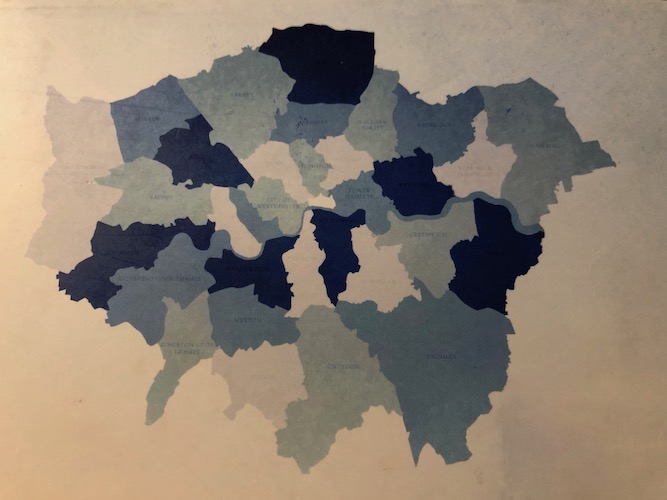One of the most baffling bits of London’s rarely entirely unbaffling boundaries comes at its south western corner. Drive from, say, Epsom to Esher, and you’ll pass from one Surrey borough to another Surrey borough, without noticing anything to suggest you’ve passed through one of the world’s great cities en route. But you have: for part of that journey you were in the Royal Borough of Kingston-upon-Thames, a corner of Greater London that protrudes jarringly out into the home counties, looking uncomfortably like London is giving Surrey the finger.
This example is extreme but hardly unique. At the opposite end of the capital, in the Central Line suburbs carved out of Essex, there’s a building containing two semi-detached homes. Officially, one of them is in Greater London; the other is not. They share a roof; they do not share a county.
To explain why some patches of suburbia were subsumed into the capital while other, near identical ones, were not, you need to go back to 1957, when the government of Harold McMillan decided it was time to replace and expand the London County Council that had been in existence since 1889. To decide exactly where the boundary should lie, it appointed a royal commission under the chairmanship of Sir Edwin Herbert, a solicitor and – rather more surprisingly – mountaineer.
As one might expect, whether a district had been swallowed by the built-up area of London was one criteria the commission used to decide whether peripheral boroughs should be in or out, but it wasn’t the only one. The various borough, district and occasionally parish councils were also given marks based on their level of urbanisation, population density, transport and commuting patterns – seven criteria in all, with each council awarded a score out of 21. Those that scored under 10 (Brentwood, Cheshunt, Watford, et al.) were automatically excluded from the new Greater London. Those that scored above 16 were shoo-ins. And in between? “Further consideration required.”
A few of the resulting scores look slightly odd from a modern perspective. Some of the suburban Essex authorities – Chigwell (20-21), Romford (20), Hornchurch (19) – scored higher than Middlesex ones like Enfield (16-17) and Hayes & Harlington (16-17) that one might perhaps expect to be more London-y. But one authority that was very definitely going into Greater London was the Surrey metropolitan borough of Epsom & Ewell: that scored the maximum of 21.
When the Herbert Commission reported in 1960, it proposed 52 new London boroughs: a Greater London not only bigger than the old London County Council, but bigger than the one that’s familiar today. Included were such areas as Cheshunt, Chigwell and Staines, as well as a huge chunk of contiguous Surrey suburbia: Caterham, Esher, Weybridge, Epsom, Banstead. In this version of Greater London, the Kingston finger didn’t exist, because the areas on either side were included, too.
So what happened? Local politics, combined with electoral self-interest. A lot of residents sent a lot of angry letters, noting that having made it and moved to Surrey, generally within living memory, they didn’t want to live in London thank you very much. The Conservative government’s interest in a bigger, and thus more Tory, Greater London was balanced by its reliance on local parties who didn’t want too much of their tax money going to subsidise the Labour-voting inner city.
And so, when the government finally published its response to Herbert’s proposals, the 52 small boroughs the commission had proposed had been replaced by 32 bigger ones. Partly this was through mergers and partly through the decision to simply leave a bunch of the outermost authorities out. Officially, there were criteria determining which these should be too (desire or otherwise to be included in the new London, whether it looked into the city or out to the county, and so on). But it is striking that most of those ultimately excluded were in the affluent Surrey commuter belt. They may have looked little different from the Outer London boroughs at the other points of the compass, but they were louder and more Tory – and thus a reason was conveniently be found to exclude them.
The result of all this is that weird finger of Greater London pointing down into the Home Counties. Kingston and Surbiton may look little different from the Surrey suburbs either side (the former, indeed, still contains a county hall; perhaps this explains the urge to give Surrey the finger). But they just didn’t manage to persuade the government to exclude them from the new London. Epsom & Ewell, its score of 21 notwithstanding, did.
Incidentally, that house with the border through the middle of it? Herbert also decided against dividing existing boroughs wherever possible. Some of those boroughs had boundaries based on those of ancient parishes – and, just occasionally, some enterprising developer had stuck a building on top. So, today there are houses which share a party wall with a neighbour who doesn’t even live in the same city as them.
Jonn Elledge is a freelance writer. Follow him on Twitter.
OnLondon.co.uk has been providing in-depth coverage of the UK capital’s politics, development and culture since February 2017. It depends greatly on donations from readers. Give £5 a month or £50 a year and you will receive the On London Extra Thursday email, which rounds up London news, views and information from a wide range of sources, plus special offers and free access to events. Click here to donate directly or contact davehillonlondon@gmail.com for bank account details. Thank you.

